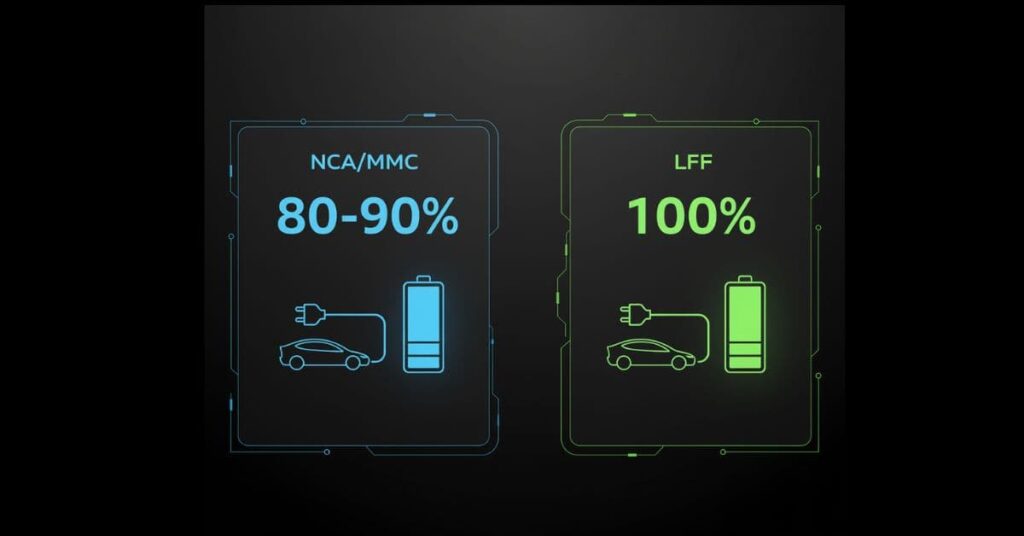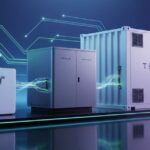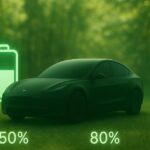You will hear about different battery types. The types are NCA, NMC, and LFP. These letters mean the chemicals inside the battery parts. Chemicals change how your car drives. Chemicals change how long the battery works. Chemicals change the battery cost. LFP batteries are safer. LFP batteries last for more charges. LFP batteries give a little less driving distance. NCA and NMC batteries give more driving distance. NCA and NMC batteries need more care to stay good. We explain all the main differences. You can choose the best Tesla battery for your daily life.
Understanding The Three Main Tesla Battery Types
Tesla uses three main types of lithium-ion batteries in its cars. Each one has a different mix of materials in its cathode (the positive side of the battery), which changes how the battery works.
1. NCA: Nickel-Cobalt-Aluminum
NCA batteries have a very high energy density. They can store much energy in a small space. Car companies often use NCA batteries in long-range and performance versions of the Model S, Model X, and older Model 3/Y cars.
- Pros: Excellent range, great acceleration, and power.
- Cons: The cost is higher. It uses cobalt. Cobalt is a disputed material. The item needs careful charging. People charge it only up to 80 or 90 percent for daily use.
2. NMC: Nickel-Manganese-Cobalt
NMC batteries resemble NCA batteries. They use manganese instead of some aluminum. The manganese makes NMC batteries more stable and a little cheaper than NCA. NMC batteries still hold a lot of energy. Tesla puts NMC batteries in some of its new long-range cars.
- Pros: Good balance of range, power, and stability.
- Cons: Still uses cobalt, and like NCA, you should not charge it to 100% every day.
3. LFP: Lithium Iron Phosphate
LFP batteries are the newest type Tesla has started using in its Standard Range Model 3 and Model Y cars. They use iron and phosphate, which are much cheaper and easier to find than nickel and cobalt.
- Pros: Very safe, lasts for many more charge cycles, and you must charge it to 100% at least once a week for the best health.
- Cons: Less energy density means less driving range for the same size battery pack.
NCA vs. NMC vs. LFP
To help you see the differences clearly, I have put the key facts about each battery type into a simple table.
| Feature | NCA (Nickel-Cobalt-Aluminum) | NMC (Nickel-Manganese-Cobalt) | LFP (Lithium Iron Phosphate) |
|---|---|---|---|
| Energy Density | Highest | High | Lowest |
| Driving Range | Longest | Long | Shorter |
| Cost | Highest | High | Lowest |
| Safety | Good | Good | Best (Very stable) |
| Lifespan (Cycles) | ~1,000–1,500 | ~1,500–2,000 | 3,000+ |
| Daily Charging Rule | Charge to 80–90% | Charge to 80–90% | Charge to 100% |
| Materials | Nickel, Cobalt, Aluminum | Nickel, Manganese, Cobalt | Iron, Phosphate (No Nickel/Cobalt) |
| Tesla Models | Older Long Range/Performance | Newer Long Range/Performance | Standard Range (Model 3/Y) |
| Cold Weather Performance | Good | Good | Range can drop more noticeably |
Tesla Batteries How Impact On Your Driving
Technical differences show how users use a Tesla daily. Choosing the correct battery means matching the battery’s good points to the user’s life.
1. Range and Performance
For long road trips or the fastest acceleration, NCA and NMC batteries are usually the better choice. They offer the maximum range available in a Tesla.
However, for most people, the difference in range with an LFP battery is not a problem. The Standard Range Model 3 with LFP still offers plenty of range for daily commuting and local trips.
2. Charging and Battery Health
This is where LFP batteries truly shine and simplify ownership.
a. LFP Batteries: People should charge LFP batteries to 100% at least once a week. The battery management system (BMS) needs to see a full charge. Seeing a full charge helps the system correctly guess the remaining range. Charging to 100% does not hurt the LFP battery.

b. NCA/NMC Batteries: People should only charge NCA/NMC batteries to 80% or 90% for regular driving. Charging to 100% and leaving it there can make the battery wear out faster. People should only charge to 100% right before they take a long trip.
Actionable Tip: If you are someone who likes to plug in and forget about it, or you want the simplest charging routine, the LFP battery is a great fit. You can set it to 100% and never worry about it.
3. Longevity and Degradation
LFP batteries are the clear winner for long-term durability. They can handle many more charge cycles (the process of charging and discharging) before they start to lose capacity.
Case Study Insight
LFP batteries are good. I saw LFP batteries in ride-share cars. These cars drove over 100,000 miles. The batteries still lost less than 5% power. The iron-phosphate part of the battery is very strong. Full charges and full discharges do not hurt the iron-phosphate part as much. Nickel batteries get hurt more by full charges and discharges.
A LFP battery’s superior cycle life helps it keep its capacity better over many years. A driver who plans to keep their Tesla for a very long time or drives very high mileage will likely see this benefit.
4. Safety And Environmental Concerns
Safety and the environment are important factors for any electric vehicle owner.
a. Thermal Stability (Safety)
LFP batteries are more stable than NCA and NMC batteries. LFP batteries are less likely to overheat and catch fire when someone damages or overcharges them. A main reason for Tesla’s shift to LFP batteries in its mass-market cars is this stability.
b. Material Sourcing (Environment)
Cobalt use in NCA and NMC batteries is a major problem. People often link cobalt mining to ethical and environmental issues. LFP batteries use no cobalt or nickel. Therefore, LFP batteries offer a more sustainable and ethical choice for getting materials.
Expert Quote: “The shift to LFP is not just about cost; it’s a strategic move towards a more sustainable and ethically sourced battery supply chain. Iron and phosphate are abundant and pose far fewer ethical challenges than cobalt”
Practical Advice for Choosing Your Tesla Battery
When you are at the point of ordering your Tesla, ask yourself these three questions:
Do I Need Maximum Range?
Yes: If you regularly drive more than 250 miles in a day or need the absolute longest range for peace of mind, choose a model with the NCA or NMC battery (usually the Long Range or Performance models).
No: If your daily driving is under 150 miles, the LFP battery in the Standard Range model is more than enough.
Do I Want the Simplest Charging Routine?
Yes: The LFP battery is perfect. Plug it in, set it to 100%, and forget about it.
No: If you are comfortable managing your charge level (setting it to 80% or 90% daily), then NCA/NMC is fine.
Am I Keeping the Car for a Long Time?
Yes: The LFP battery’s high cycle life and low degradation make it the best choice for long-term ownership and high mileage.
No: If you plan to sell the car in 3-5 years, the difference in degradation between the types will be minimal, and you can focus on range or performance.
Conclusion
Selecting the best Tesla battery ultimately comes down to your driving habits, charging preferences, and long-term plans. NCA and NMC batteries deliver impressive range and performance, making them ideal for long trips or high-speed driving. However, they require more careful charging habits and contain cobalt, which raises ethical and environmental concerns.
On the other hand, LFP batteries provide exceptional safety, durability, and a simple charging routine. With over 3,000 charge cycles and no reliance on cobalt or nickel, LFP packs are perfect for daily commuting, long-term ownership, and environmentally conscious drivers—even if their range is slightly lower.
Summary: If you prioritize maximum range and acceleration, NCA or NMC is the way to go. But if you want longevity, low maintenance, and sustainability, LFP is the smarter choice. Understanding these differences helps you match the battery type to your lifestyle, ensuring your Tesla performs reliably for years to come.
FAQs
Can I charge an LFP battery to 100% every day?
Yes, charge the LFP battery to 100% every day. Tesla suggests charging LFP batteries to full 100% at least once a week. Full charging keeps the battery management system (BMS) working correctly. Charging LFP to 100% every day does not hurt the battery much. This differs from NCA or NMC batteries.
Which battery is better in cold weather?
1. All lithium-ion batteries lose some driving distance in the cold.
2. NCA and NMC batteries work a little better in very cold weather.
3. LFP batteries can lose more driving distance.
4. LFP batteries might need warming up before they can charge fast.
5. Tesla’s computer program manages this by heating the battery first.
How can I tell which battery my Tesla has?
Look at the charge screen in your car or the Tesla app. If the car lets you set the daily charge limit all the way to 100%, your car has an LFP battery. There will be no separate “Daily” and “Trip” lines. If the car tells you to charge only to a lower number, like 80% or 90%, for daily driving, your car has an NCA or NMC battery.
Do LFP batteries weigh more than NCA/NMC?
Yes, LFP batteries are heavier for the same energy amount stored. LFP batteries hold less energy for their size. This lower energy density means cars with LFP batteries often drive a slightly shorter distance than cars with NCA or NMC batteries, even if the battery packs are about the same size.
Is it true that LFP batteries are safer?
Yes, LFP batteries are chemically safer. LFP batteries can handle more heat before they break down. This means they are much less likely to catch fire compared to NCA and NMC batteries.







